NCERT Solutions for Class 6 Mathematics Exercise 10.3
|
NCERT Answers for Class 6 Maths Chapter 10 |
Mensuration Exercise 10.3
Page 219
Ex 10.3 Class 6 Maths Question 1. Find the areas of the rectangles whose sides are : (a) 3 cm and 4 cm (b) 12 m and 21 m (c) 2 km and 3 km (d) 2 m and 70 cm
Answer
We know that
Area of rectangle = Length × Breadth
(a) l = 3 cm and b = 4 cm
Area = l × b = 3 × 4
= 12 cm2
(b) l = 12 m and b = 21 m
Area = l × b = 12 × 21
= 252 m2
(c) l = 2 km and b = 3 km
Area = l × b = 2 × 3
= 6 km2
(d) l = 2 m and b = 70 cm = 0.70 m
Area = l × b = 2 × 0.70
= 1.40 m2
Ex 10.3 Class 6 Maths Question 2. Find the areas of the squares whose sides are :
(a) 10 cm (b) 14 cm (c) 5 m
Answer
(a) Area of square = side2
= 102
= 100 cm2
(b) Area of square = side2
= 142
= 196 cm2
(c) Area of square = side2
= 52
=25 cm2
Ex 10.3 Class 6 Maths Question 3.The length and breadth of three rectangles are as given below :
(a) 9 m and 6 m (b) 17 m and 3 m (c) 4 m and 14 m
Which one has the largest area and which one has the smallest?
Answer
(a) Area of rectangle = l × b
= 9 × 6
= 54 m2
(b) Area of rectangle = l × b
= 17 × 3
= 51 m2
(c) Area of rectangle = l × b
= 4 × 14
= 56 m2
Area of rectangle 56 m2 i.e (c) is the largest area and area of rectangle 51 m2 i.e (b) is the smallest area
Ex 10.3 Class 6 Maths Question 4. The area of a rectangular garden 50 m long is 300 sq m. Find the width of the garden.
Answer
Area of rectangle = length × width
300 = 50 × width
width = 300 / 50
width = 6 m
Therefore, the width of the garden is 6 m
Ex 10.3 Class 6 Maths Question 5. What is the cost of tiling a rectangular plot of land 500 m long and 200 m wide at the rate of ₹ 8 per hundred sq m.?
Answer
Area of land = length × breadth
= 500 × 200
= 1,00,000 m2
Therefore, cost of tiling 1,00,000 sq m of land = (8 × 1,00,000) / 100
= ₹ 8000
Ex 10.3 Class 6 Maths Question 6. A table-top measures 2 m by 1 m 50 cm. What is its area in square metres?
Answer
Given
l = 2m
b = 1m 50 cm = 1.50 m
Area = l × b = 2 × 1.50
= 3 m2
Ex 10.3 Class 6 Maths Question 7. A room is 4 m long and 3 m 50 cm wide. How many square metres of carpet is needed to cover the floor of the room?
Answer
Given
l = 4m
b = 3 m 50 cm = 3.50 m
Area = l × b = 4 × 3.50
=14 m
Ex 10.3 Class 6 Maths Question 8. A floor is 5 m long and 4 m wide. A square carpet of sides 3 m is laid on the floor. Find the area of the floor that is not carpeted.
Answer
Area of floor = l × b = 5 × 4
= 20 m2
Area of square carpet = 3 × 3
= 9 m2
Area of floor that is not carpeted = 20 – 9
= 11 m2
Therefore, area of the floor that is not carpeted is 11 m2
Ex 10.3 Class 6 Maths Question 9. Five square flower beds each of sides 1 m are dug on a piece of land 5 m long and 4 m wide. What is the area of the remaining part of the land?
Answer
Area of flower square bed = 1 × 1
= 1 m2
Area of 5 square bed = 1 × 5
= 5 m2
Area of land = 5 × 4
= 20 m2
Remaining part of the land = Area of land – Area of 5 square bed
= 20 – 5
= 15 m2
Therefore, remaining part of the land is 15 m2
Ex 10.3 Class 6 Maths Question 10. By splitting the following figures into rectangles, find their areas (The measures are given in centimetres).
Answer
(a)
Area of HKLM = 3 x 3 = 9 cm2
Area of IJGH = 1 x 2 = 2 cm2
Area of FEDG = 9 cm2
Area of ABCD = 2 x 4 = 8 cm2
Total area of the figure = 9 +2 + 9 +8 = 28 cm2
(b)
(b) Area of ABCD = 3 x 1 = 3 cm2
Area of BDEF = 3 x 1 = 3 cm2
Area of FGHI 3 x 1 = 3 cm2
Total area of the figure = 3 + 3 + 3 = 9 cm2
Ex 10.3 Class 6 Maths Question 11. Split the following shapes into rectangles and find their areas. (The measures are given in centimetres)
Answer
(a)
Area of rectangle ABCD = 2 x 10 = 20 cm2
Area of rectangle DEFG = 10 x 2 = 20 cm2
Total area of the figure = 20 + 20 = 40 cm2
(b)
There are 5 squares each of side 7 cm.
Area of one square = 7 x 7 = 49 cm2
Area of 5 squares = 49 x 5 = 245 cm2
(c)
Area of rectangle ABCD = 5 x 1 = 5 cm2
Area of rectangle EFGH = 4 x 1 = 4 cm2
Total area of the figure = 5 + 4 cm2
Ex 10.3 Class 6 Maths Question 12. How many tiles whose length and breadth are 12 cm and 5 cm respectively will be needed to fit in a rectangular region whose length and breadth are respectively: (a) 100 cm and 144 cm (b) 70 cm and 36 cm.
Answer
(a) Area of rectangle = 100 × 144
= 14400 cm
Area of one tile = 5 × 12
= 60 cm2
Number of tiles = (Area of rectangle) / (Area of one tile)
= 14400 / 60
= 240
Hence, 240 tiles are needed
(b) Area of rectangle = 70 × 36
= 2520 cm2
Area of one tile = 5 × 12
= 60 cm2
Number of tiles = (Area of rectangle) / (Area of one tile)
= 2520 / 60
= 42
Hence, 42 tiles are needed
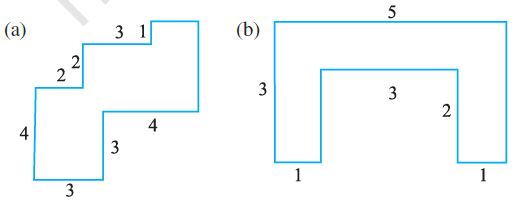
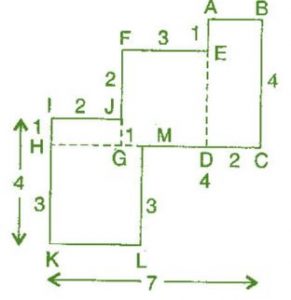
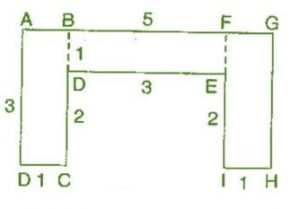
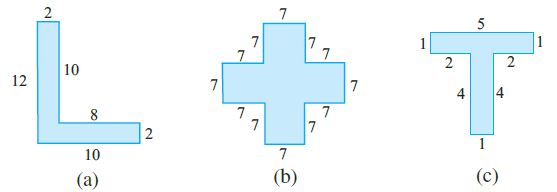
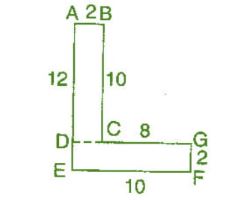
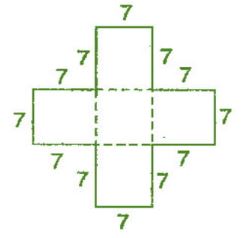

No doubt… Very good